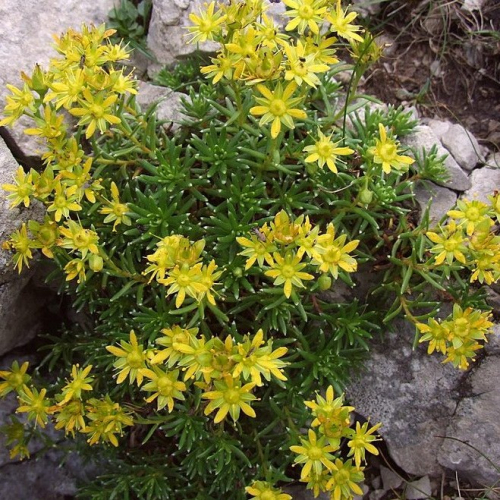Perennials Saxifrаga

Description
Characteristic Features of Saxifraga
Saxifraga is a large genus of mostly perennial plants belonging to the family Saxifragaceae. The members of this genus are found in the mountains in temperate and arctic habitats, as well as in tropical Africa.
Both Russian and Latin names refer to their ability to grow in rocky crevices between stones. Saxifrages are also commonly known as rockfoils.
Saxifraga forms clumps and can reach a height of 5 to 70 centimetres. The root system is strong. The leaves are creeping, collected a rosette, typically round, often serrated, and slightly hairy. In many species, the margins are greyish, because the leaves produce lime. The star-shaped flowers in single clusters or inflorescences grow up to 2 centimetres across, have five petals, and may be white, yellow, purple, or pink. Flowers are borne from late spring until August. The fruit is a capsule with numerous small black seeds maturing in September.
Saxifraga is perfect for alpine gardens and rockeries or as groundcover. Tall species are also used in flower borders and mixed borders. The best companions for Saxifraga are the Iris, Gentian, Cloves, Stonecrop, and dwarf conifers. Most species are suitable for forcing and can rebloom in February and March. In addition, Saxifraga is a medicinal plant that helps in the treatment of many diseases.
The Saxifraga genus contains about 400 species, often substantially different from each other. In the wild, the most common species are:
Lifelong Saxifrage or White Mountain Saxifrage (Saxifraga paniculata) is a groundcover with narrow greyish leaves and white, reddish, or pale yellow panicles.
Ascending Saxifrage (Saxifraga adscendens) grows about 10 centimetres tall and has short leaves and small milky beige flowers.
Saxifraga aprica has oval green and purple leaves and white flowers.
Matte Saxifrage (Saxifraga bronchialis) has lanceolate leaves and white flowers with lemon and orange spots.
Tufted Saxifrage (Saxifraga caespitosa) has ternary leaves and white flowers.
Drooping Saxifrage, Nodding Saxifrage, or Bulblet Saxifrage (Saxifraga cernua) has brownish leaves and single drooping white flowers.
Cushion Saxifrage (Saxifraga eschscholtzii) has silvery shiny leaves and small yellow flowers.
Saxifraga ferruginea has leaves with toothed margins, high stems, and flowers with differently shaped petals (three wide and two narrow petals).
Yellow Marsh Saxifrage, Marsh Saxifrage, or "Bog Saxifrage" (Saxifraga hirculus) does not develop a rosette and has yellow flowers.
Purple Saxifrage or Purple Mountain Saxifrage (Saxifraga oppositifolia) is a matted plant growing only to 5-20 centimetres tall, with opposite terracotta leaves and lilac or purple flowers.
Landscape designers mostly use hardy species like London Pride (Saxifraga x urbium) that grows up to 30 centimetres tall, has leathery leaves, and blooms in the early summer or Saxifraga x arendsii that includes a wide variety of hybrids and cultivars. Strawberry Saxifrage (Saxifraga stolonifera) and Saxifraga sarmetosa that grow up to 50 centimetres in height are grown as indoor and medicinal plants.
The Secrets to Successfully Growing Saxifraga
In view of the diversity of species, there is no single growing method for Saxifraga. Some species prefer damp and fertile soil with good drainage, while others sunny areas with alkaline soils. Some members of the genus require shady areas with dry ground. However, these plants are generally undemanding and can thrive in any area. What is essential is good drainage. For lush and profuse flowering, plant Saxifraga in lightweight well-drained soils and ensure the plants get enough light.
The basic care for Saxifraga includes abundant watering (Allow the top soil to dry out completely between waterings), weeding, deadheading and winter sheltering with a thin layer of dry leaves, although some species can safely overwinter without sheltering. It is useful to fertilize once a month. A few years later the plant loses its ornamental effect, so it needs to be rejuvenated.
Saxifraga is propagated from seed before winter or spring, cuttings and suckers in mid-summer, and dividing the clump in August.
Seeds of some species require stratification, so it is better to sow in open ground in late autumn. The seeds of Saxifraga x arendsii that is particularly valued by growers do not require stratification. They can be sown indoor in March or outdoor in April–May, after the danger of spring frost has passed. When sowing, only slightly cover the seeds with soil and water regularly. Seedlings will appear in 2–3 weeks. When the seedlings develop actual leaves, prick out and plant out to a permanent location around July or August spacing 10–30 centimetres. In the winter, shelter the young plants with spruce branches or dry leaves. If you grow Saxifraga in a container, the container should be shallow, wide, and well-drained. Use a mix based on peat and river sand.
Cut the cuttings in June and July, cover with polyethylene film or glass, or use a propagator, water well and plant out to a permanent location in the spring. The plants will flower next summer.
After flowering, Saxifraga can be propagated by suckers. Plant them in the fertile soil, protect from direct sunlight, and water regularly. In the winter, cover and in the spring plant out to a permanent location.
You can propagate Saxifraga by dividing the clump in late summer. Dig out, carefully divide into several parts, and plant in prepared locations spacing about 20 centimetres.
Potential Problems
Too bright or too low sunlight can cause the leaves wilt or develop brown spots.
Saxifraga does not tolerate waterlogged soil, so it is very important to prevent root rot. Keep the soil moderately moist. If the rosette of leaves is turning black, treat with fungicides.
If the air is too dry, plants can be affected by thrips, spider mites, scale insects, and aphids. Control pests using special insecticides.


 64 361
64 361








